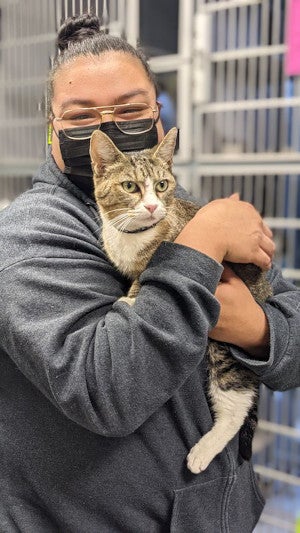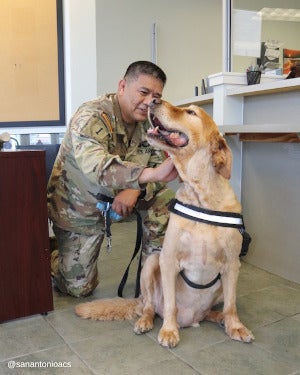
The trick to attracting media attention
Ensuring your organization’s messaging is a hot media commodity
December 6th, 2022
In 2015, a dog named Rosie ended up as part of a cruelty case at the City of San Antonio Animal Care Services (SAACS), and her story ended up making international news.

When people heard that Rosie had been “punished” for going after her person’s chickens by having hydrochloric acid poured on her head and face, they were unsurprisingly angry – and moved. Rosie received get-well cards from dog lovers around the world, as well as enough donations to more than cover the retinal surgeries that saved her eyesight.
SAACS went viral again in December 2021 when the shelter shared the sweet news about the reunion of a woman with her cat Monkey Face, who had gone missing on moving day six years prior. And in August of this year, local media picked up the tale of Lucky. The goofy golden retriever decided to take himself for a walk one day – unbeknownst to his person, who was shocked to find out the dog he thought was lounging at home was out wandering around Joint Base San Antonio-Lackland Air Force Base. SAACS used Lucky’s microchip to return him to his baffled family.

In between, the media picked up countless stories from the shelter: from pleas for assistance during times of overcrowding to many of the happy-ever-after kind of stories that are the bread-and-butter for publications, TV news, and social media. Right now, you might be thinking, “Well, our organization has plenty of stories like that! How do we go about getting that kind of attention?!” Well, Lisa Norwood, SAACS’s public relations and outreach manager, is here to share some pro tips.
Spreading the news, both down the street and across the globe
Lisa and the rest of her communications team, comprising an assistant manager and a marketing specialist, have no end of material to share. After all, this is a shelter that took in more than 24,000 dogs and cats in fiscal year 2022. So, the team makes ample use of social media, posting at least twice a day, seven days a week on Facebook and Instagram.
“We’ve seen an interesting phenomenon in our social media marketing over the last several years; it has increasingly led to a noticeable jump in earned media,” Lisa says.
(If you aren’t familiar with the term, earned media is essentially any coverage you don’t pay for. It’s free publicity, no matter if it shows up on the TV news, a local paper or other social media that is not managed by SAACS.)
In fact, SAACS’s social media content has become so coveted by local press, it’s often used word for word off the shelter’s Facebook page.
“This ‘passive PR’ happens regularly and often several times a week,” Lisa says. “Snappy headlines, great pictures…even video make all the difference, and because of the nature of media feeds, the stories often go viral across the country.”
It’s also not unusual for the shelter’s social media posts to be featured on Latin American, European or Asian media channels. While SAACS’s primary audience is the local community, such broader reach makes a difference when it comes to partnering with national industry leaders.
“San Antonio is our home, but the more attention we can draw to animal care issues globally, the more leverage (and support) we have to change things in our own backyard,” she says. “That really makes a difference when we work with organizations like Best Friends, who can fund and push through comprehensive impacts our solitary organization cannot.”
Go beyond the “warm and fuzzy” with your messaging
Speaking of impact…Lisa stresses that, no matter how engaging a story is on its face, the shelter is intentional about “weaving in educational nuggets.”
The importance of microchipping, the devastating impact of animal cruelty,” she says. “Including such detail is the way we work back towards our common message of humane pet care.
This tactic can also lead a story to “grow legs,” as they like to say in the media world. Rosie’s story spurred a local motorcycle club to put on a fundraising “Ride for Rosie.” Subsequent media updates continued regularly for a year until she healed, found placement, and her attacker was sentenced to prison.

“Rosie’s story is also one of the reasons we were able to not only move forward with a more robust communications team, but we were also able to get better equipment,” says Lisa, who had been the sole PR/marketing staffer from 2006 up until that point in 2015. “The point-and-shoot camera we used for her update pictures didn’t do justice to the severity of her injury.”
Speaking of which, even if you don’t have a budget, you should find a way (a social media story requesting donations, perhaps?) to invest in the best – people, programs, and resources.
“Get the best digital cameras and photo editing software you can afford,” Lisa says. “Invite a local media photographer or pet photographer to teach a class at the shelter. Contact the national organizations that help shelters maximize their photography and bio skills. It makes a difference.”
It’s all about who you know – or who you make a point of knowing
The biggest difference you can make for your organization is to create and sustain strong relationships. That’s the key to sound media relations, Lisa says.
“Media relations is an apropos term; so much of the press coverage we get is based on relationships,” she says.
The press are people trying to do a job just like we are. It makes sense to make that relationship mutually beneficial.
While Lisa comes from a media background, and uses that knowledge daily, it’s not a prerequisite to building professional relationships.
“It helps to speak the same language (literally) that reporters do but it’s not a deal breaker,” she says.

To create and keep good rapport with media outlets, SAACS’s communications team makes sure someone is always available to answer a reporter’s questions. If they don’t have an answer, they can easily get one because they’ve also cultivated relationships with all kinds of animal subject matter experts.
“We regularly have media contact us to ask about animals outside of our purview,” Lisa says. “I have proven to media that I understand what they need and when they need it. This sort of informal, “street-style” approach is the antithesis of standard PR approaches, but it works for me (and I think it works for animal shelters).”
So, what are Lisa’s “don’ts” for catching the eye of a writer or editor looking to fill column inches, airtime, or social media slots?
“I do not call media after every press release goes out to pitch those same stories,” she says. “I do not call the press on the day of an event to ask whether they’ll be attending to cover it. I absolutely avoid press conferences and formal types of press statements (unless forced to).
“And I do not pay to place stories or appear on morning shows; all media is earned media,” she continues. “Finally, the best advice I would have for organizations looking to up their media game is this: Tell your shelter’s story because if you don’t someone else will…and you may not like the beginning, middle or end.”

Liz Finch
Senior Writer
Best Friends Network
If you enjoyed this program spotlight, you can find our complete catalog of spotlights here.